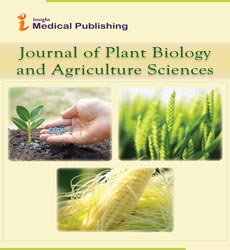Recognize Plant Smells and Spectroscopy and Biophotonics
Zhenxiao Sun*
Department of Botany, Federal Urdu University of Arts, Science and Technology, Karachi 75300, Pakistan
*Corresponding author: Zhenxiao Sun, Department of Computer Sciences, University of Agriculture Faisalabad, Faisalabad, Pakistan; E-mail:
sun123@gmail.com
Received date: December 13, 2021; Accepted date: December 27, 2021; Published date: January 3, 2022
Citation: sun Z (2022). Recognize Plant Smells and Spectroscopy and Biophotonics.J Plant Bio Agric Sci Vol.5 No.8:108.
Introduction
Plant pathology (additionally phytopathology) is the logical investigation of sicknesses in plants brought about by microbes and natural conditions [1]. Organisms that cause irresistible illness incorporate growths, oomycetes, microorganisms, infections, viroids, infection like organic entities, phytoplasmas, protozoa, nematodes and parasitic plants. Excluded are ectoparasites like bugs, parasites, vertebrate, or different nuisances that influence plant wellbeing by eating plant tissues. Plant pathology additionally includes the investigation of microbe recognizable proof, illness etiology, infection cycles, monetary effect, plant sickness the study of disease transmission, plant infection opposition, what plant illnesses mean for people and creatures, pathosystem hereditary qualities, and the executives of plant sicknesses. Control of plant infections is critical to the dependable creation of food, and it gives huge issues in agrarian utilization of land, water, fuel and different sources of info. Plants in both normal and developed populaces convey intrinsic illness opposition, however there are various instances of wrecking plant infection impacts, like the Great Famine of Ireland and chestnut scourge, as well as repetitive serious plant sicknesses like rice impact, soybean growth nematode, and citrus blister [2]. Be that as it may, infectious prevention is sensibly fruitful for most harvests. It is accomplished by utilization of plants that have been reproduced for great protection from numerous infections, and by plant development approaches, for example, crop turn, utilization of microorganism free seed, proper establishing date and plant thickness, control of field dampness, and use of pesticides. Proceeding with propels in the study of plant pathology are expected to further develop infectious prevention, to stay aware of the continuous advancement and development of plant microbes, and to stay up with changes in farming practices [3]. Biotrophic Parasitic Microorganisms Plant infections cause major financial misfortunes for ranchers around the world - see Economic sway. Across huge areas and many harvest species, it is assessed that infections normally decrease plant yields by 10% consistently in more evolved settings, yet yield misfortune to sicknesses regularly surpasses 20% in less evolved settings. The Food and Agriculture Organization gauges that irritations and illnesses are answerable for around 25% of harvest misfortune. To tackle this, new strategies are expected to identify sicknesses and nuisances early, for example, novel sensors that recognize plant smells and spectroscopy and biophotonics that can analyze plant wellbeing and digestion. In many pathosystems, destructiveness is reliant upon hydrolases - and the more extensive class of cell divider corrupting proteins - that debase the cell divider. By far most of CWDPs are microbe delivered and gelatin focused on (for instance, pectinesterase, pectate lyase, and pectinases)[4]. For microorganisms the cell divider polysaccharides are themselves a food source, however generally a hindrance to be survived. Numerous microorganisms likewise develop shrewdly when the host separates its own phone dividers, most frequently during organic product aging. Most phytopathogenic growths have a place with the Ascomycetes and the Basidiomycetes. The parasites imitate both physically and agamically through the creation of spores and different designs. Spores might be spread significant distances via air or water, or they might be soil borne. Many soil possessing growths are fit for living saprotrophically, doing the piece of their life cycle in the dirt[5]. These are facultative saprotrophs. Parasitic sicknesses might be controlled using fungicides and other horticulture rehearses. In any case, new races of organisms regularly develop that are impervious to different fungicides. Biotrophic parasitic microorganisms colonize living plant tissue and acquire supplements from living host cells. Necrotrophic parasitic microorganisms contaminate and kill have tissue and concentrate supplements from the dead host cells. Critical contagious plant microbes incorporate. Most microorganisms that are related with plants are really saprotrophic and cause no damage to the actual plant. Nonetheless, a modest number, around 100 known species, can cause disease.Bacterial sicknesses are substantially more common in subtropical and tropical locales of the world.Most plant pathogenic microorganisms are bar formed (bacilli). To have the option to colonize the plant they have explicit pathogenicity factors. Five primary sorts of bacterial pathogenicity factors are known: employments of cell divider debasing catalysts, poisons, effector proteins, phytohormones and exopolysaccharides. Microorganisms, for example, Erwinia species use cell divider corrupting compounds to cause delicate decay. Agrobacterium species change the degree of auxins to cause growths with phytohormones. Exopolysaccharides are created by microbes and square xylem vessels, regularly prompting the demise of the plant.
References
1. Mielke MM, Lyketsos CG (2006) Lipids and the pathogenesis of Alzheimer’s disease: is there a link? Int Rev Psychiatry 18: 173-186.
2. von Bergmann K, Sudhop T, Lütjohann(2005)Cholesterol and plant sterol absorption: recent insights. Am J Cardiol. 96: 10-14.
3. Leoni V, Caccia C (2011)Oxysterols as biomarkers in neurodegenerative diseases. Chem Phys Lipids. 164: 515-524.
4. Björkhem I, Meaney S (2004)Brain cholesterol: long secret life behind a barrier. Arterioscler Thromb Vasc Biol. 24: 806-815.
5. Lütjohann D, von Bergmann K (2003) 24S-hydroxycholesterol: a marker of brain cholesterol metabolism. Pharmacopsychiatry. 36: 102-106. J
Open Access Journals
- Aquaculture & Veterinary Science
- Chemistry & Chemical Sciences
- Clinical Sciences
- Engineering
- General Science
- Genetics & Molecular Biology
- Health Care & Nursing
- Immunology & Microbiology
- Materials Science
- Mathematics & Physics
- Medical Sciences
- Neurology & Psychiatry
- Oncology & Cancer Science
- Pharmaceutical Sciences
